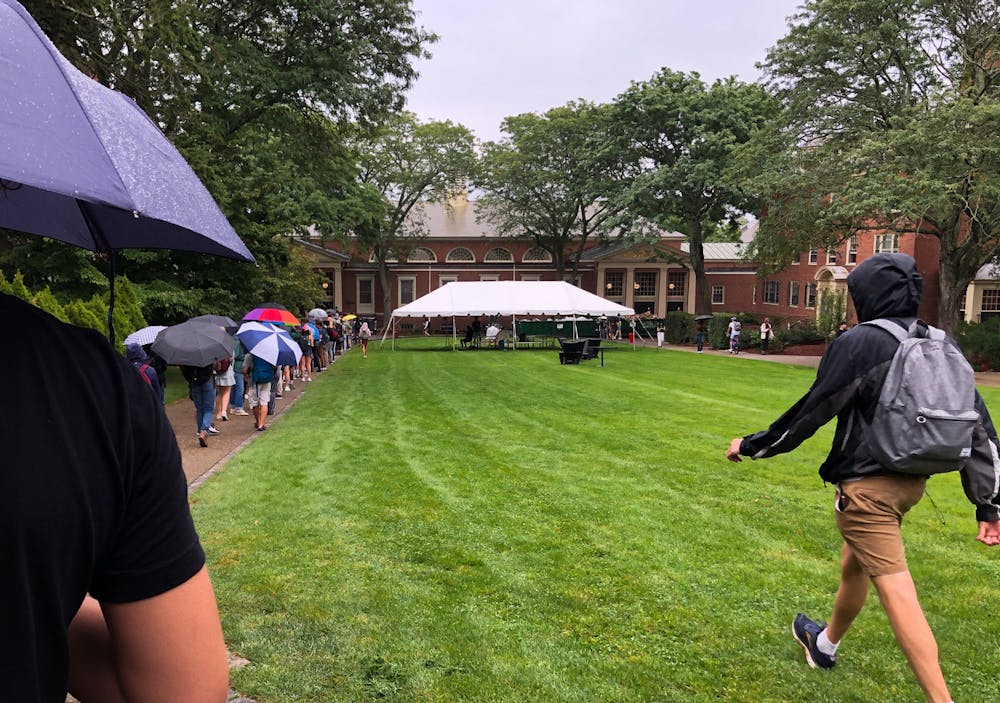In addition to worrying about his senior seminars and thesis, Leonardo Moraveg ’22 faced an additional stressor at the start of this year — mealtimes. Moraveg, who spoke with The Herald Sept. 14, deliberately pushed his meals hours later than normal to avoid what he called the “record-breaking lines” of the dining halls.
Moraveg is just one of many students whose mealtimes have been affected by the extended wait times at the dining halls. Since University dining halls originally opened for in-person dining at the start of the fall semester, before the University’s recent transition to takeout meals in response to rising COVID-19 case numbers on campus, students experienced overcrowding, prolonged wait times and dissatisfaction with meal options.
“You have to sacrifice not getting food because of classes,” said Fadilatou Toure ’25, as she stood in a Sharpe Refectory line extending all the way up to Wayland Arch. She said she enjoyed sitting with her friends and being in a social environment, but sometimes finds herself standing in queues without knowing what food options await at their end because of the long lines.
The issue is temporary, according to Director of Dining Services George Barboza.
Rita Slaoui ’23.5 stood in a 35-minute line to get a poke bowl from Andrews Commons, all the while lamentingBrown’s two-year meal plan mandate that gave her no option but to purchase a meal plan.
Jessie Curran, director of wellness and nutrition, wrote in an email to The Herald that the two-year meal plan requirement “is in place to ensure the University is addressing concerns of food insecurity among students. That concern has not gone away during the pandemic.”
But Slaoui expressed frustration with the lack of food options at dining halls. “It’s definitely better than last year. But compared to pre-pandemic, it has gotten so much worse,” she said.
“Brown Dining continually introduces new recipes and food items in our planning process,” Curan wrote. “Specifically, menu items are rotated in cycles for variety.”
The fact that the Blue Room does not accept meal credits or flex points anymore further limits Slaoui’soptions. Last Monday, Slaoui’s roommates went to the Ratty, Andrews and the Ivy Room for dinner, but, due to the long wait times, eventually decided to buy pizza from Thayer — “which again is ridiculous when you pay so much for a meal plan that you’re forced to be on,” Slaoui said.
Moraveg pointed out that the long lines are a recurring problem.
“You truly know that it’s a systemic issue when the problem is seen across the entire board,” he said.
Longer lines during peak hours (11:45 am to 1:00 pm and 5:30 pm to 7:00 pm) are common during the first few weeks of the semester because students are still solidifying their schedules, Curran wrote, suggesting that students visit the dining halls during non-peak hours to encounter fewer lines.
“Dining Services continues to evaluate operations and introduce concepts that improve the student experience,” wrote Curran. One of the solutions that Brown provided is the “Meals in a Minute” program that allows students to order a meal online for quicker pick-up. But this program applies only during lunch hours.
Despite these issues, Moraveg has chosen to stay on meal plan because, “for a student like me who has a heavy schedule and is always on the go, it’s better to be on meal plan.”
He added that the cost of his meal plan has increased by more than $300 from his first year. “They’re continuously increasing the price of the meal plans without increasing the quality of the service. For a student on financial aid, or even for regular students who aren’t on financial aid, if there is an increase in price then at least keep the service at the same level. But if the service is decreasing, then what am I paying for?”
In response, Curran wrote, “Brown Dining uses only the highest quality ingredients in our operations” and partners with local farmers and producers. “Our recipes are prepared from scratch and menus are written considering seasonality and availability of regional ingredients.”
“I think the reason why there isn’t a big outrage about this is because people who have to be on meal plan are mostly (first-years)and sophomores. … They don’t really have a reference point,” Slaoui said. “People are so happy to have opportunities to eat in person that they don’t see what’s been taken away.”
Students have taken to social media as an outlet for their frustration and have created several memes about the Ratty lines.
“There might be some people that think students are overblowing it,” Moraveg said, “but at the point where there are clusters of people trying to exit or find a single seat or table, that’s when you know you have an issue.”





